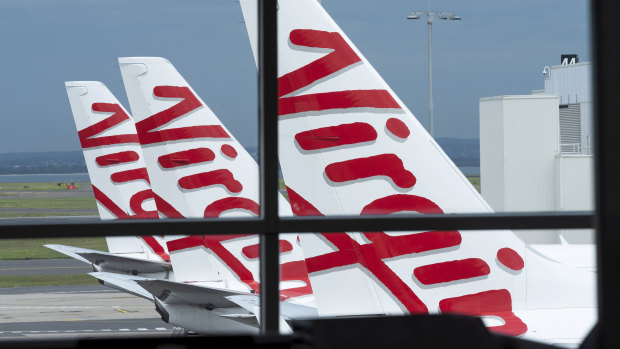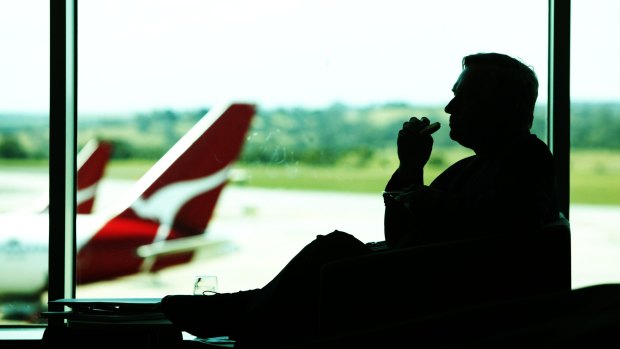This was published 3 years ago
Opinion
Redux: The Virgin Australia of the future is set to be very different - but very familiar
Stephen Bartholomeusz
Senior business columnistWhichever of the two bidders for Virgin Australia wins the auction it is apparent that they will try to recreate a version of the airline from its past, one that will be quite different to the Virgin that plunged into administration at the onset of the coronavirus.
It will nevertheless be familiar and has a very good chance of being, not just viable but highly profitable. We know that because Virgin has been there and done that before.

The race to save Virgin is down to two bidders.Credit: Rhett Wyman
The two private equity players left in the contest for Virgin – Bain and Cyrus Capital – have now both provided a broad outline of their strategy for the carrier: Bain nearly three weeks ago and Cyrus at the weekend. In broad outline they are strikingly similar.
They involve smaller fleets, focused on Virgin’s narrow-bodied Boeing 737s, stripping out the costs and complexity of flying the seven different aircraft types Virgin had in the fleet when it crashed.
The Tiger Australia brand is seen as a distraction, adding costs and complexity for little if any return. Similarly, while both bidders appear to envisage some level of international presence in future, it seems international routes aren’t a material element of either’s strategy for a relaunch.
A much smaller and simpler fleet flows through into far smaller staff numbers, although both bidders appear impressed by the energy of Virgin’s employees and both want to recapture the original youthful "challenger" spirit of the brand.
While getting to the point where Virgin can emerge from administration under new ownership with a viable future is quite complex, given that the bids have to deal with $6.8 billion of liabilities amid a pandemic and border closures that makes future demand difficult to forecast, it isn’t surprising that both bidders have broadly similar strategies.
That’s because anyone looking at the Australian aviation industry and any awareness of its recent history would come to the same set of conclusions: it would be suicidal to try to compete directly with Qantas for corporate customers and, given the strength of Jetstar, there isn’t sufficient volume and margin available to return to Virgin’s roots as a low-cost carrier.
It cost Virgin $2 billion over a decade to discover the obvious: Qantas, with its contracts, frequency and loyalty program, has a stranglehold on corporate business. No matter how fancy the lounges or good the service, Virgin failed to make much more than a dent in Qantas’ share of the corporate market.
All that profitless gold-plating did – at a time when Qantas was ripping out its own costs - was to sacrifice most of the material cost advantage Virgin once had over Qantas while allowing Jetstar space to grow within the more cost-sensitive segments of the market.

Virgin's ill-fated bid to take corporate customers from Qantas was not successful. Credit: Jessica Hromas
With Qantas dominating corporate travel and Jetstar entrenched as the low-cost carrier, Virgin needs – as it started to do once Paul Scurrah was appointed chief executive – to carve into its cost base as it repositions its offer.
The administration process, if the bidders can take full advantage of it, offers the potential to do far more in a far shorter timeframe than Scurrah and his team would have been able to within the constraints of the rafts of contractual agreements for planes, labour and infrastructure baked into the airline’s operations.
Stripped of the gold-plating and costs of the ill-fated ambition to challenge Qantas, there is a model for Virgin that has been successful overseas and which would be very familiar to those who were part of the original, extremely profitable, decade of Virgin’s history.
When Geoff Dixon launched Jetstar in 2004 it challenged Virgin’s original and conventional low-cost carrier positioning. Brett Godfrey – the entrepreneur who dreamed up and then executed the launch of Virgin in Australia – responded quickly by shifting Virgin slightly up-market.
It would be suicidal to try to compete directly with Qantas for corporate customers and, given the strength of Jetstar, there isn’t sufficient volume and margin available to return to Virgin’s roots as a low-cost carrier.
He dubbed it a "New World Carrier" strategy but essentially it was a version of the "hybrid" strategy that the Virgin bidders are now talking about. – targeting a position between Jetstar and Qantas and using its low cost base to offer leisure travellers a product up-market of Jetstar’s and business travellers (rather than corporates) a lower-cost but still full-service product.
Providing Virgin has costs within sight of Jetstar’s but below Qantas’ it can attract value-driven customers while segmenting its cabins to offer differentiated services at different price points. Others – like Air New Zealand or Canada’s Westjet – do exactly that.
As long as Virgin doesn’t directly challenge Qantas and Jetstar for their core customer bases and is disciplined on how much capacity it puts into the market they will focus on maximising their own margins and profits, leaving – as the original Virgin understood – plenty of profit available to a disciplined competitor.
Private equity players are focused on profits and would understand, despite Virgin’s more recent track record, there are hundreds of millions of dollars a year available from the domestic duopoly.
That doesn’t mean Virgin won’t compete with Qantas and Jetstar but that the competition will be rational and profit-driven, as Virgin’s once was. The gold-plating will go, as will the delusion that Virgin can wrest Qantas’ corporate dominance from it.
Scurrah would have pursued a similar goal with a similar philosophy but it would have taken longer and Virgin would have had less flexibility and been encumbered with higher costs than the new Virgin will have.
The bidders now have only a week before submitting their final bids, which will need to incorporate some substantial provisions for the uncertainties generated by the pandemic about what a new normal for the domestic market might look like and when that might emerge.
They will have to fund Virgin through a potentially lengthy period – perhaps several years – of losses as they and Qantas scramble to attract whatever passenger volumes are available as travel restrictions gradually fall away and the slow build towards a more stable market gets underway.
That’s something Virgin’s creditors, if they want to avoid a liquidation and a total wipe-out, will also have to think deeply about.
Get our Morning & Evening Edition newsletters
The most important news, analysis and insights delivered to your inbox at the start and end of each day. Sign up to The Sydney Morning Herald’s newsletter here, to The Age’s newsletter here and Brisbane Times' here.